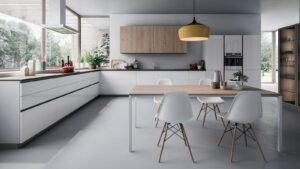Shiplap walls have become increasingly popular in interior design, adding a rustic yet modern touch to any space. To help you navigate the world of shiplap walls, we’ve consulted top designers who share their expertise on how to pull off this trend seamlessly.
Understanding the Appeal of Shiplap Walls
Before diving into the design possibilities, it’s essential to understand the appeal of shiplap walls. Shiplap has a fascinating history that dates back to centuries ago.
Shiplap walls, with their distinctive overlapping boards, have become a popular choice for homeowners and designers seeking to add texture and interest to their spaces. But what is it about shiplap that makes it so appealing?
The history of shiplap walls can be traced back to their origins in shipbuilding. Originally used for its durability and weather resistance, shiplap quickly became a sought-after construction technique for homes as well. The overlapping boards not only provided strength and stability but also created a visually pleasing pattern.
The History of Shiplap Walls
Originally used in shipbuilding, shiplap walls were prized for their durability and weather resistance. Over time, this construction technique made its way into homes, with its distinctive overlapping boards creating texture and interest.
Imagine yourself standing on the deck of a majestic sailing ship, the wind in your hair and the salty scent of the sea filling your nostrils. The ship’s hull, built with shiplap walls, stands strong against the crashing waves and unpredictable weather. This same strength and resilience are what attracted builders to incorporate shiplap walls into homes.
As the popularity of shiplap walls grew, so did the demand for different variations of the design. Today, you can find shiplap walls in various materials, such as wood, MDF, and even PVC. This versatility allows homeowners and designers to achieve the desired aesthetic while still benefiting from the practicality and charm of shiplap.
Why Shiplap Walls are Trending
Shiplap walls have made a comeback in recent years due to their timeless and versatile nature. The clean lines and classic charm they provide make them a favorite among homeowners and designers alike.
One of the reasons shiplap walls have become so popular is their ability to fit seamlessly into a wide range of interior design styles. Whether you prefer a rustic farmhouse look or a modern minimalist vibe, shiplap walls can be incorporated to enhance the overall aesthetic.
Furthermore, shiplap walls offer a sense of warmth and coziness to any space. The natural wood grain and the way the boards overlap create a visual depth that adds character and charm. It’s no wonder that shiplap walls have become a go-to choice for creating focal points in living rooms, bedrooms, and even bathrooms.
Another factor contributing to the trendiness of shiplap walls is their versatility. While traditionally used on walls, shiplap can also be applied to ceilings, kitchen islands, and even as a decorative accent on furniture. This flexibility allows for endless creative possibilities and ensures that shiplap remains a design staple for years to come.
The Basics of Shiplap Wall Design
Now that we’ve explored the allure of shiplap walls, it’s time to delve into the basics of shiplap wall design.
Shiplap walls have become increasingly popular in interior design due to their rustic charm and versatility. They add a touch of warmth and character to any space, whether it’s a cozy farmhouse-style home or a modern industrial loft. But designing shiplap walls involves more than just slapping some wooden boards on your wall. It requires careful consideration of materials, colors, and finishes to create a stunning and cohesive look.
Choosing the Right Materials for Shiplap Walls
One of the essential decisions you’ll make is selecting the right materials for your shiplap walls. While traditional shiplap is made of solid wood, there are now engineered options available that offer increased durability and stability. These engineered shiplap boards are made from a combination of wood fibers and resins, making them less prone to warping, shrinking, or expanding with changes in temperature and humidity.
When it comes to wood choices, pine is a popular and cost-effective option for shiplap walls. It has a beautiful grain pattern and is relatively easy to work with. Other hardwoods like cedar, oak, or walnut can also be used for a more luxurious and unique look. However, keep in mind that hardwoods are generally more expensive and may require additional finishing steps to achieve the desired appearance.
Deciding on the Perfect Color and Finish
Color and finish play a crucial role in the overall aesthetic of your shiplap walls. While white is the classic choice for shiplap, don’t be afraid to experiment with different shades to achieve a unique look. Soft pastels like light blue or pale gray can create a calming and serene atmosphere, while bolder colors like navy or black can add drama and sophistication to your space.
In addition to color, the finish of your shiplap walls can also make a significant impact. A smooth, glossy finish can give your walls a more modern and polished look, while a distressed or weathered finish can enhance the rustic charm of the shiplap. You can achieve different finishes through various techniques such as sanding, staining, or painting. Consider the overall style and ambiance you want to create in your space when deciding on the perfect color and finish for your shiplap walls.
Expert Tips on Installing Shiplap Walls
Installing shiplap walls may seem intimidating, but with these expert tips, you’ll be able to tackle the project with confidence.
Shiplap walls have gained popularity in recent years due to their rustic and timeless appeal. They add character and warmth to any space, making them a popular choice for both modern and traditional interiors. Whether you’re looking to transform your living room, bedroom, or even a bathroom, shiplap walls can be a great option.
Preparing Your Wall for Shiplap
Before installation, ensure that your wall is properly prepared. This step is crucial for a successful shiplap installation. Start by removing any existing wallpaper or paint. It’s important to have a clean and bare surface to work with. If there are any damages or imperfections on the wall, take the time to repair them. Fill in any holes or cracks and sand the surface to create a smooth canvas for your shiplap boards.
Once you’ve prepared the wall, it’s time to consider the layout and design of your shiplap. Think about the direction you want the boards to run and whether you want to cover the entire wall or just a portion of it. Planning ahead will help you achieve the desired look and ensure a seamless installation.
The Installation Process
When it comes to installing shiplap, it’s all about precision. Measure twice and cut once to guarantee a perfect fit. Start by measuring the height and width of your wall, taking into account any outlets, windows, or doors that may affect the placement of the boards. Use a pencil to mark the measurements on your shiplap boards before cutting them.
Before attaching the boards to the wall, it’s essential to ensure that they are straight and level. Use a level to check the alignment of each board before nailing or screwing them in place. This step is crucial for achieving a polished and professional-looking result.
When it comes to attaching the boards, you have a few options. You can use nails or screws, depending on your preference and the look you’re going for. If you choose to use nails, make sure they are long enough to penetrate both the shiplap boards and the wall behind them. If you opt for screws, choose ones that are specifically designed for wood and ensure they are countersunk to create a flush finish.
As you progress with the installation, periodically step back and assess the overall look. This will help you identify any gaps or inconsistencies and make adjustments as needed. Remember, shiplap installation requires patience and attention to detail.
Once you’ve completed the installation, take a moment to admire your handiwork. Shiplap walls can instantly transform a space, adding texture and visual interest. Whether you choose to leave the shiplap in its natural state or paint it to match your decor, it’s a design element that is sure to impress.
Designers’ Secrets to Styling Shiplap Walls
Styling shiplap walls can elevate the overall aesthetic of your space. Let’s uncover some designers’ secrets on how to achieve that perfect balance.
Complementing Shiplap with Other Design Elements
To create a cohesive look, consider how your shiplap walls can work with other design elements. Pair them with neutral furniture, pops of color, or eye-catching artwork to add depth and interest to your space.
Maintaining the Aesthetic of Shiplap Walls
As with any design feature, maintenance is key to preserving the aesthetic of your shiplap walls. Regularly clean the surface and address any potential water damage to ensure your shiplap walls stay looking fresh and beautiful.
Common Mistakes to Avoid with Shiplap Walls
While shiplap walls can enhance your interior design, there are a few common mistakes that you should be mindful of.
Overdoing the Shiplap Look
It’s important to strike a balance when incorporating shiplap into your space. Avoid covering every wall in shiplap, as it can overpower the room. Instead, use shiplap as an accent wall or focus on specific areas to maintain a tasteful aesthetic.
Ignoring the Room’s Existing Style
When introducing shiplap walls, it’s essential to consider the existing style of the room. Ensure that shiplap aligns with the overall design scheme, creating a harmonious and holistic space.
By following these expert insights and tips from top designers, you’ll be equipped to pull off shiplap walls with confidence and style. Embrace the timeless appeal and create a space that exudes charm and character.



